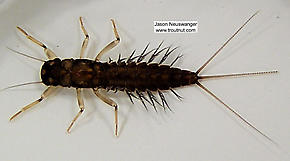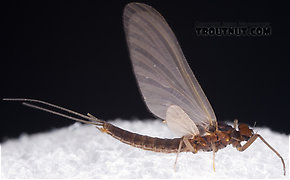Blog & Latest Updates
Fly Fishing Articles
Insects by Common Name


Dark Blue Quills
Scientific Names
| Match | Scientific Name |
| Paraleptophlebia | |
| Neoleptophlebia adoptiva | |
| Teloganopsis deficiens |
Like most common names, "Dark Blue Quill" can refer to more than one taxon. They're previewed below, along with 7 specimens. For more detail click through to the scientific names.
Mayfly Genus Paraleptophlebia
These are very rarely called Dark Blue Quills.
There are many species in this genus of mayflies, and some of them produce excellent hatches. Commonly known as Blue Quills or Mahogany Duns, they include some of the first mayflies to hatch in the Spring and some of the last to finish in the Fall.
In the East and Midwest, their small size (16 to 20, but mostly 18's) makes them difficult to match with old techniques. In the 1950s Ernest Schwiebert wrote in Matching the Hatch:
Fortunately, modern anglers with experience fishing hatches of tiny Baetis and Tricorythodes mayflies are better prepared for eastern Paraleptophlebia. It's hard to make sense of so many species, but only one is very important and others can be considered in groups because they often hatch together:
In the East and Midwest, their small size (16 to 20, but mostly 18's) makes them difficult to match with old techniques. In the 1950s Ernest Schwiebert wrote in Matching the Hatch:
"The Paraleptophlebia hatches are the seasonal Waterloo of most anglers, for without fine tippets and tiny flies an empty basket is assured."
Fortunately, modern anglers with experience fishing hatches of tiny Baetis and Tricorythodes mayflies are better prepared for eastern Paraleptophlebia. It's hard to make sense of so many species, but only one is very important and others can be considered in groups because they often hatch together:
- Paraleptophlebia adoptiva is by far the most important species of this genus in the two regions and is an early Spring emerger.
- Paraleptophlebia mollis, Paraleptophlebia guttata, and Paraleptophlebia strigula complement each other in late spring and early summer.
- Paraleptophlebia debilis and Paraleptophlebia praepedita occur together in the fall.
- The most important species is Paraleptophlebia debilis. This large (for the genus) Fall emerger can be found throughout the region. It is often accompanied by one of the slightly larger tusked species. Depending on locale, this can be Paraleptophlebia bicornuta (the most common), Paraleptophlebia packii or Paraleptophlebia helena. Check out their hatch pages for distribution information.
- Spring is the season for the smaller Paraleptophlebia heteronea throughout most of the region with Paraleptophlebia gregalis filling this niche in California and parts of Oregon.
Female Paraleptophlebia (Blue Quills and Mahogany Duns) Mayfly Dun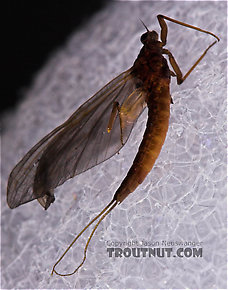 View 4 PicturesI really hoped to catch some good blue quill specimens on this trip, but they are very fragile mayflies and this one was in the best condition of the few that I caught after I drove them home to my camera. It may not be pretty, but you get an idea of the size/shape/color anyway.
View 4 PicturesI really hoped to catch some good blue quill specimens on this trip, but they are very fragile mayflies and this one was in the best condition of the few that I caught after I drove them home to my camera. It may not be pretty, but you get an idea of the size/shape/color anyway.
 View 4 PicturesI really hoped to catch some good blue quill specimens on this trip, but they are very fragile mayflies and this one was in the best condition of the few that I caught after I drove them home to my camera. It may not be pretty, but you get an idea of the size/shape/color anyway.
View 4 PicturesI really hoped to catch some good blue quill specimens on this trip, but they are very fragile mayflies and this one was in the best condition of the few that I caught after I drove them home to my camera. It may not be pretty, but you get an idea of the size/shape/color anyway.Male Paraleptophlebia (Blue Quills and Mahogany Duns) Mayfly Spinner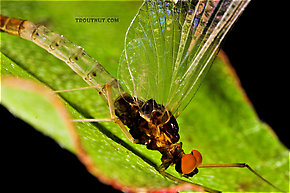 View 15 PicturesI wasn't actually fishing the river where I caught this one. I was just scouting, didn't like the look of the water, and as I was walking back to the car this little dun landed on my vest. Why can't they all be so easy to collect?
View 15 PicturesI wasn't actually fishing the river where I caught this one. I was just scouting, didn't like the look of the water, and as I was walking back to the car this little dun landed on my vest. Why can't they all be so easy to collect?
 View 15 PicturesI wasn't actually fishing the river where I caught this one. I was just scouting, didn't like the look of the water, and as I was walking back to the car this little dun landed on my vest. Why can't they all be so easy to collect?
View 15 PicturesI wasn't actually fishing the river where I caught this one. I was just scouting, didn't like the look of the water, and as I was walking back to the car this little dun landed on my vest. Why can't they all be so easy to collect?Female Paraleptophlebia (Blue Quills and Mahogany Duns) Mayfly Adult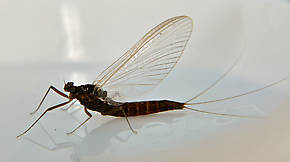 View 1 PicturesThis female exhibits the dark chocolate color so common in this genus.
View 1 PicturesThis female exhibits the dark chocolate color so common in this genus.
 View 1 PicturesThis female exhibits the dark chocolate color so common in this genus.
View 1 PicturesThis female exhibits the dark chocolate color so common in this genus.See 26 more specimens...
Mayfly Species Neoleptophlebia adoptiva
These are very rarely called Dark Blue Quills.
This is the best Spring hatch after the Quill Gordons (Epeorus pleuralis) but before the Hendricksons (Ephemerella subvaria) in most parts of the East, although it can overlap with both. The Blue Quills are small mayflies (hook size 16-20) but they can hatch in incredible numbers at a time when eager trout are just beginning to look to the surface after a hungry winter.
Male Neoleptophlebia adoptiva (Blue Quill) Mayfly Spinner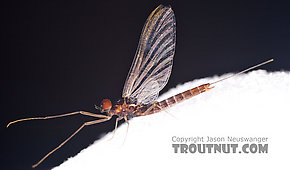 View 7 PicturesBased on the pale longitudinal forewing veins (excepting the costals), dark middle terga (Tergum: the dorsal part of an abdominal segment or segments (terga). Also used to describe the entire abdominal dorsum or the thoracic dorsal segments of Odonata.), and genitalia (Burks '53), this specimen is P. adoptiva.
View 7 PicturesBased on the pale longitudinal forewing veins (excepting the costals), dark middle terga (Tergum: the dorsal part of an abdominal segment or segments (terga). Also used to describe the entire abdominal dorsum or the thoracic dorsal segments of Odonata.), and genitalia (Burks '53), this specimen is P. adoptiva.
 View 7 PicturesBased on the pale longitudinal forewing veins (excepting the costals), dark middle terga (Tergum: the dorsal part of an abdominal segment or segments (terga). Also used to describe the entire abdominal dorsum or the thoracic dorsal segments of Odonata.), and genitalia (Burks '53), this specimen is P. adoptiva.
View 7 PicturesBased on the pale longitudinal forewing veins (excepting the costals), dark middle terga (Tergum: the dorsal part of an abdominal segment or segments (terga). Also used to describe the entire abdominal dorsum or the thoracic dorsal segments of Odonata.), and genitalia (Burks '53), this specimen is P. adoptiva.Mayfly Species Teloganopsis deficiens
These are very rarely called Dark Blue Quills.
Anglers in western Wisconsin, where these little flies hatch in good numbers on summer rivers, have termed them "Darth Vaders" because of the very dark color of their wings.
Until recently, this species was known as Serratella deficiens.
Until recently, this species was known as Serratella deficiens.
Teloganopsis deficiens (Little Black Quill) Mayfly Nymph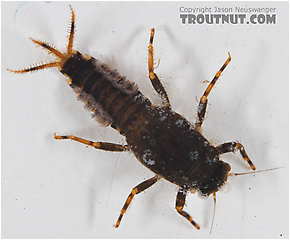 View 6 PicturesThis nymph has tiny, barely detectable tubercles (
View 6 PicturesThis nymph has tiny, barely detectable tubercles (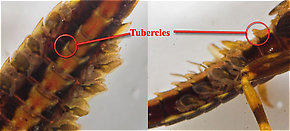 Tubercle: Various peculiar little bumps or projections on an insect. Their character is important for the identification of many kinds of insects, such as the nymphs of Ephemerellidae mayflies.) on its abdominal segments, and I could not find the maxillary palpi. I have tentatively guessed that it is Serratella deficiens.
Tubercle: Various peculiar little bumps or projections on an insect. Their character is important for the identification of many kinds of insects, such as the nymphs of Ephemerellidae mayflies.) on its abdominal segments, and I could not find the maxillary palpi. I have tentatively guessed that it is Serratella deficiens.
 View 6 PicturesThis nymph has tiny, barely detectable tubercles (
View 6 PicturesThis nymph has tiny, barely detectable tubercles (
A few (not all) of the abdominal tubercles on this Ephemerella needhami nymph are circled. They are especially large in this species.
Top 10 Fly Hatches
Top Gift Shop Designs
Eat mayflies.
Top Insect Specimens
Miscellaneous Sites
Troutnut.com is copyright © 2004-2024 Jason
Neuswanger (email Jason). See my FAQ for information about use of my images.
 privacy policy
privacy policy

